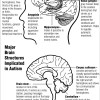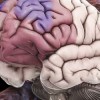Naughty or nice? The Moral Molecule

Oxytocin (ball-and-stick) bound to its carrier protein neurophysin (ribbons) based on: "Crystal structure of the neurophysin-oxytocin complex" Rose, J.P., Wu, C.K., Hsiao, C.D., Breslow, E., Wang, B.C. (1996) Nat.Struct.Biol. 3: 163-169
I recently enjoyed a truly mind-blowing talk at the New York Academy of Sciences. The Neuroeconomist (yes, he studied Economy and is founding director of Claremont´s Center for Neuroeceonomic Studies) Paul J. Zak spoke about his research on the brain chemical oxytocin (OXT) – the so-called “love hormone” – and how he showed that OXT is the source of love and prosperity, triggering a wide variety of physical and psychological effects in both women and men. In his experiments he measures OXT levels found in the blood stream of thousands of people in a variety of settings: attending a wedding, playing football, on Facebook, or play economic games in a lab. By comparing OXT levels before and after those emotionally-charged activities, he found that the level always spiked up during the activity. And interestingly, this is followed by more relaxed, trusting and caring social behavior. Oxytocin seems to be a hidden master controller of human behavior.
The hormone’s influence on our behavior and physiology originates in the brain, where it’s produced by a structure called the hypothalamus, then transferred to the pituitary gland, which releases it into the bloodstream. Like antennas picking up a signal, OXT receptors are found on the outside of cells throughout a body. As Dr. Zak showed, OXT levels tend to be higher during both stressful and socially-bonding experiences (see references for details). So how did it evolve?
Oxytocin is a peptide hormone found in almost all mammals. The present day OXT molecule evolved from a fish “fight-or-flight” molecule called vasotocin. By a random mutation, vasotocin changed one day into a two-amino acid shortened version, called isotocin. Isotocin reduced anxiety in the fish so it relaxed, which facilitated mating instead of a fight-or flight stress response. A variant of isotocin then finally became oxytocin. Similarly, vasopressin evolved into the variant arginine-vasopressin which still works in modern humans as a molecular guide towards reproductive and moral behavior. Oxytocin and vasopressin are the only hormones released by the posterior pituitary gland that can affect cells in distant parts of the body.
For a long time OXT was best known for its role in sexual reproduction, in particular during and after childbirth. But recent studies show that OXT also plays a role in ‘tribal’ behavior and trustworthiness.
Oxytocin helps our brains break down the barrier between self and others, allowing us all to practice empathy and feeling towards others. And so our brains respond to observed pain or pleasure in the same way as the pain would be happening if we were actually experiencing it; we literally experience the other person’s pain or pleasure as if it were our own.
The higher our OXT level, the closer we appear to act on the Golden Rule: You be nice to me and I´ll be nice to you. On a cellular level we need OXT-producing neurons and functioning OXT receptors in the brain. Oxytocin also directly influences the release of the two feel-good neurochemicals: dopamine and serotonin. However stress, trauma, testosterone, mental conditioning and genetic anomalies can inhibit this effect and with dropping OXT levels our moral behavior strays from the Golden Rule (though, depending on the circumstances this could be a good thing, too!).
People with chronic OXT deficiency do have altered social behavior, depending on the degree of OXT impairment. This can range from high-functioning and brilliant autism to psychopaths. Furthermore, genetic differences in the OXT receptor gene (OXTR) have been associated with maladaptive social traits, such as aggressive behavior.
The good news is that we can consciously use the “moral molecule” to make our own lives better. Oxytocin can be easily transiently boosted by a loving relationship, meditation, dance, connecting via social media and even a simple hug. Dr. Zak – who refers to himself as “Dr. Love” – told the audience I was part of to “share the love” and give a minimum of eight hugs a day! He promises that if you give eight hugs a day you´ll be happier, and the world will be a better place because you will be actively causing other people’s brains to release OXT.
Let´s hope that they are susceptible to the moral molecule and in turn will treat others more generously, causing them to release more OXT….you got the idea! The Beatles already sung it: “Love is all you need….”
————————————————-
Further reading:
Zak, Paul J. (2012), The Moral Molecule: the source of love and prosperity. Dutton, Penguin Publishing group.
Zak PJ, Stanton AA, Ahmadi S (2007). Brosnan, Sarah. ed. “Oxytocin Increases Generosity in Humans”. PLoS ONE 2 (11): e1128. doi:10.1371/journal.pone.0001128. PMC 2040517. PMID 17987115.
Kosfeld M, Heinrichs M, Zak PJ, Fischbacher U, Fehr E (2005). “Oxytocin increases trust in humans”. Nature 435 (7042): 673–6. doi:10.1038/nature03701. PMID 15931222.
Kirsch P, Esslinger C, Chen Q et al. (2005). “Oxytocin modulates neural circuitry for social cognition and fear in humans”. The Journal of Neuroscience 25 (49): 11489–93. doi:10.1523/JNEUROSCI.3984-05.2005. PMID 16339042.
Shamay-Tsoory SG, Fischer M, Dvash J, Harari H, Perach-Bloom N, Levkovitz Y (2009). “Intranasal administration of oxytocin increases envy and schadenfreude (gloating)”. Biological Psychiatry 66 (9): 864–70. doi:10.1016/j.biopsych.2009.06.009. PMID 19640508.
| Print article | This entry was posted by Christine Marizzi on January 9, 2013 at 4:29 pm, and is filed under G2C Online. Follow any responses to this post through RSS 2.0. You can leave a response or trackback from your own site. |








